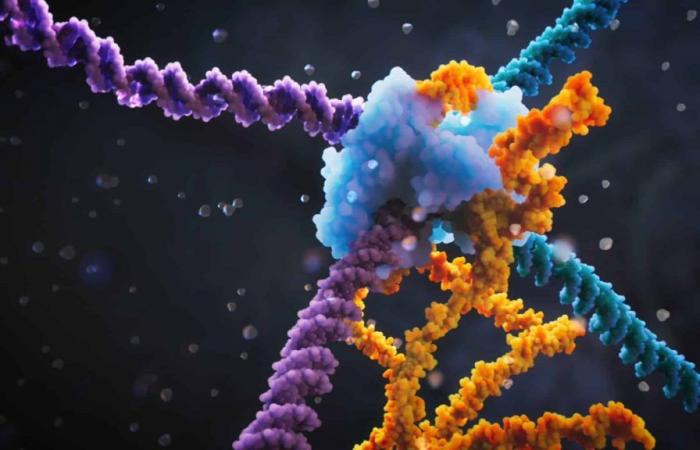⇧ [VIDÉO] You may also like this partner content
Researchers have developed a new gene editing technique that can completely reshape the genome. Called “bridge editing,” it can, among other things, induce much more significant changes than are currently possible with CRISPR, including by directly inserting new DNA sequences into the genome. This gives it a level of precision never before achieved with current editing techniques.
RNA-guided systems have revolutionized our understanding of the genome. Among these systems is the gene editing technique CRISPR, which functions as molecular “scissors” guided by guide RNAs (gRNAs). The technique makes it possible, among other things, to section and modify a specific genetic sequence by personalizing the gRNA.
The whole process is mediated by the CRISPR protein Cas. The term Cas refers to a nuclease that binds to a short CRISPR RNA (crRNA) targeting the relevant DNA or RNA sequences. The endonucleases Cas9 and Cas12 cleave DNA, while Cas13 cleaves RNA. When the molecular tool cleaves the sequence to be targeted, the cell systematically induces a repair process. Cleavage is carried out repeatedly until the cell naturally mutates by inducing a repair error.
However, although the CRISPR technique makes it possible to induce a mutation at specific sites, its level of precision is relatively limited. It cuts and damages target sequences to inactivate them, making it more of a destructive technique than an editing one.
To remedy this, improved versions of CRISPR have been proposed, allowing for example to directly modify target sequences rather than relying on repair-mutation cycles. Some allow nucleotide bases to be modified without going through the cleavage process, while others allow gRNAs to be converted into DNA and inserted into the sequence to be targeted. However, here again, the precision remains limited.
A team from the Arc Institute, the University of California, Berkeley, Stanford, and Tokyo, has proposed a new programmable editing technique that would allow new DNA sequences to be inserted directly into the genome using “bridge RNAs” – a new class of guide RNAs. This would dramatically improve the precision of gene editing using a single insertion sequence.
« The RNA bridging system is a fundamentally new mechanism for genome design “, explains in an Arc Institute blog post the study’s principal investigator, Patrick Hsu, also a professor of bioengineering at the University of California, Berkeley. Bridge recombination can universally modify genetic material through insertion, excision, inversion of specific sequences and more, enabling more efficient living genome editing than CRISPR ».
“Bridge RNA”: a universal adapter allowing targeting any part of the genome
Discovered in bacteria and archaea, the new molecular editing system studied by the team is based on a sequence called “insertion 110 (IS110)”. It is part of a large set of transposable sequences (or “jumping genes”) that cut, move within the genome, then stick (or insert) between two specific strands.
These short sequences are present in the cells of all living beings and have evolved to become real tools for manipulating DNA. IS110 in particular consists of a gene coding for a recombinase enzyme, responsible for genetic recombination. It is a process that leads to the modification of the physical association between two segments of DNA.
Experts in the new study — published in the journal
Nature — used cryo-electron microscopy to study the molecular structures of the RNA bridge-recombinase complex. They progressed in stages from the IS110 cleavage process to the recombination phase.
They discovered that when IS110 is excised from the genome, the non-coding ends of the DNA strand come together to produce two bridging RNA loops. One of the loops binds to IS110 while the other binds to the target strand where the new sequence will be inserted — making bridging RNA the first example of a bispecific gRNA. The recombinase then induces the insertion process.
On the other hand, each bridge RNA is programmable, which allows any target and donor DNA sequence to be combined. In other words, the tool allows any DNA sequence to be inserted into any target genomic location. These programmable RNA bridges distinguish IS110 from other known recombinases, which do not contain an RNA component and cannot be programmed. “, explains the study’s co-lead author, Nicolas Perry, also of the Arc Institute and the University of California. For the analogy, “it’s as if the ARN bridge is a universal power adapter that makes IS110 compatible with any outlet,” he says.
See as well
IS110 mobile genetic elements express a (non-coding) ncRNA bound by its encoded recombinase. aSchematic representation of the IS110 recombinase protein sequence. bSchematic representation of the structure and life cycle of an IS110 element. cA mid-rooted phylogenetic tree constructed from 1,054 IS110 recombinase sequences. dDistribution of non-coding end lengths across eight IS families. eRNA sequencing coverage plot of concatenated non-coding ends of IS621 and five related orthologs expressed from their endogenous promoter in bacteria E. coli . fDepiction of an IS621 recombinase fluorescently labeled with either wild-type or scrambled ncRNA to measure the equilibrium dissociation constant (KD). gConsensus secondary structure of ncRNAs constructed from 103 IS110 sequences. ©
Matthew G. Durrant et al.
Accuracy of over 94%
This mechanism gives the new system a level of precision that could never be obtained with the CRISPR technique. When testing bacteria Escherichia colithe team demonstrated that the efficiency of inserting a given gene was more than 60%, while the ability to insert at the correct location was more than 94%.
Furthermore, the technique makes it possible to recombine two strands of DNA without releasing the previously cleaved ends of the latter. These so-called “scar” sequences constitute a significant limitation of the genetic editing techniques currently used.
However, it is important to note that the technique has so far only been tested on bacteria and its effectiveness on other types of cells, including humans, remains to be proven. However, it could ultimately open the way to new types of gene therapies. According to experts, future research will focus on applying the tool to human cells, improving its precision and efficiency, as well as exploring potential additional functions.
Explanatory video of the study:






